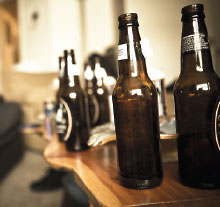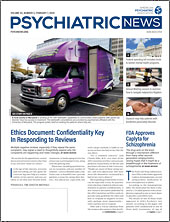DBS Improves Outcomes in Some OCD Patients
Deep brain stimulation (DBS) may lead to improvements in patients with treatment-resistant obsessive-compulsive disorder (OCD), according to a report in AJP in Advance.
The open-label study by researchers at the University of Amsterdam involved 70 OCD patients with treatment-resistant OCD—defined as “no or insufficient response” to multiple treatments, including selective serotonin reuptake inhibitors (SSRIs) at maximum dosages, at least one attempt at augmenting SSRIs with an atypical antipsychotic, and cognitive-behavioral therapy.
The study participants received DBS of a region called the ventral anterior limb of the internal capsule (vALIC).
The researchers used the Yale-Brown Obsessive Compulsive Scale (Y-BOCS) to assess OCD symptoms before DBS surgery, two weeks after the DBS implantation, monthly up to six months after surgery, and at a follow-up at 12 months. The researchers also assessed anxiety symptoms in the patients using the Hamilton Anxiety Rating Scale (HAM-A) and depression symptoms using the Hamilton Depression Rating Scale (HAM-D). The patients were asked about side effects at each visit.
They found that from baseline to follow-up at 12-months, the patients’ mean Y-BOCS score decreased by 40%. Over this same period, the mean HAM-A score decreased by 55%, and the mean HAM-D scores decreased by 54%.
“Our study confirms our previous finding that DBS of the vALIC is an effective and tolerable treatment for refractory OCD,” they concluded.
Forced Awakening Less Problematic for Patients on Suvorexant
Recently approved sleep aids that target the orexin receptor like suvorexant appear to produce less impairment following forced awakening than popular GABA receptor–targeting medications like zolpidem. The findings were published in PNAS.
The finding points to a potential benefit of insomnia medications targeting the orexin receptor, as the ability to arouse and respond to unexpected stimuli is an important feature of normal sleep.
Researchers at the University of Tsukuba in Japan randomly assigned 30 healthy men to take 20 mg of suvorexant, 0.25 mg of brotizolam (a zolpidem relative available in Europe and Japan), or a placebo pill 15 minutes before bedtime. The trial was a crossover design so that each participant took each of the three pills on different days. Ninety minutes later the researchers woke the participants.
The participants completed physical and cognitive tests (such as measuring balance, agility, and reaction time) right before they took their pill, after the forced awakening, and again the next morning.
Both sleep aids were similar at improving time to sleep during the initial 90 minutes and after the forced awakening. Brotizolam, however, significantly impaired participants’ overall post-awakening performance (combined scores on the tests) relative to placebo. Participants performed similarly on post-awakening tests after taking suvorexant and placebo. When assessing individual tests, brotizolam was most significantly associated with poor post-awakening balance with eyes open relative to suvorexant.
Phased Psychotherapy Effective for PTSD/SUD
Recent Veterans Affairs guidelines recommend that patients with posttraumatic stress disorder (PTSD) and a substance use disorder (SUD) receive treatment for both disorders at the same time. A study appearing in Drug and Alcohol Dependence suggests that psychotherapy that sequentially introduces elements of PTSD and SUD recovery is as effective as an integrated PTSD/SUD therapy.
Investigators at the University of Pennsylvania and colleagues assigned 183 veterans with PTSD and SUD to receive either a phased or integrated program of motivational enhancement therapy for SUD and exposure therapy for PTSD. The former motivates patients to change adverse substance use behaviors while the latter has patients face their trauma to overcome it.
In the integrated program, the veterans received 16 90-minute sessions that combined both therapeutic strategies. For the phased approach, veterans received four 90-minute sessions of motivational enhancement therapy and health education. This was followed by 12 90-minute sessions of exposure therapy that included a brief substance use check-in at the start. If the therapists determined SUD issues needed more attention, then additional motivational enhancement was provided. The participants had 20 weeks to complete all 16 sessions.
At the study’s end, both groups achieved clinically meaningful reductions in their SUD and PTSD symptoms, with no statistical difference between the groups.
The researchers noted that adherence was a problem for patients in both groups (average of 8.5 of 16 sessions attended), though the participants in the phased program did have a slightly higher rate of completion (36% versus 23%).
Based on this study, the investigators recommended that therapists “make the decision as to whether to phase or integrate individual [evidence-based practices] in collaboration with their patients.”
Brain Circuit Provides New Clues to Compulsive Drinking
Researchers at the Salk Institute and Vanderbilt University have identified a brain circuit in mice that appears to predict the animals most likely to develop compulsive drinking behaviors.
“This research bridges the gap between circuit analysis and alcohol/addiction research and provides a first glimpse at how representations of compulsive alcohol drinking develop across time in the brain,” said Kay Tye, Ph.D., of Salk in a press release. The study was published in Science.
The researchers gave mice unlimited access to alcohol, followed by a period in which alcohol was mixed with quinine to create a bitter taste. They then divided the mice into three groups: those who drank little alcohol throughout (low drinkers), those who binged but then stopped once quinine was introduced (high drinkers), and those that kept on drinking (compulsive drinkers).
The researchers found that mice with compulsive drinking had greater activity in a neural circuit that connects the medial prefrontal cortex (which regulates decision-making) with the brainstem (which regulates aversive behaviors like pain). Interestingly, this circuit showed differential activity between high drinkers and compulsive drinkers even during early stages of the binge drinking process, when both groups of mice appeared the same behaviorally.
Using a technique called optogenetics in which light energy is used to alter the rate of neuron firing, the researchers found they could stop compulsive drinking behaviors in these mice when alcohol was mixed with quinine. Optogenetics did not decrease drinking when alcohol was available by itself, however. This suggests the cortical-brainstem circuit contributes to compulsive drinking via decreasing the sensitivity to punishment.
More Child Pychiatrists, but Regional Gaps Remain
From 2007 to 2016, the number of child psychiatrists in the United States per 100,000 children increased by nearly 22%, outpacing overall population growth. Still, some 70% of U.S. counties remained without a child psychiatrist in 2016. The findings were published in Pediatrics.
Investigators from the RAND Corporation used county-level resource files available from the Department of Health and Human Services to compare changes in the numbers of child psychiatrists by county over time.
Between 2007 and 2016, the number of practicing child psychiatrists in the United States rose from 6,590 to 7,991. During this same time, the number of U.S. children (aged 0 to 19 as defined by the U.S. Census Bureau) declined from 82.22 to 81.95 million. This resulted in a ratio of 1 child psychiatrist for every 10,256 children in 2016, up from 1 per 12,477 children in 2007. In addition, the number of states that had at least 10 child psychiatrists per 100,000 children rose from 11 in 2007 to 14 in 2016.
Despite the uptick in child psychiatrists, 74.7% of all U.S. counties had no child psychiatrists, which was similar to the 2007 rate. At the same time, 80% of all children resided in a county with a child psychiatrist, reflecting a greater proportion of child psychiatrists in densely populated urban areas.
“[C]ounties with few or no child psychiatrists may need to look to alternative or complementary frameworks to address child mental health needs, including integration of behavioral health in pediatric primary care settings, school-based mental health services, child psychiatry telephone consultation access programs, and new models of telepsychiatry,” the researchers wrote. ■





